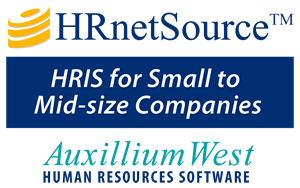Installing a New Human Resources Information System (HRIS)
Purpose of Process (see below how HRnetSource™ can help):
To automate record keeping and reporting tasks in order to improve the efficiency of the Human Resources function.
Recommended Steps in the Process:
- Select an HRIS selection and implementation team, consisting
of representatives from Payroll, Human Resources and Information
Resources.
- Create a list of requirements (see sample), such as:
- Hardware/operating system requirements
- Compatibility with other systems
- Report Writer capabilities
- Interface with Payroll System (or integrated HR/Payroll)
- Implementation schedule
- Required modules (e.g. benefits, flexible benefits, COBRA capable, compensation, salary planning, retirement plans, applicant tracking, recruiting, time and attendance, skill, education, bonus/incentives, EEO/Affirmative Action, stock option, health and safety)
- Budget limitations
- Use the Internet or referrals to identify potential vendors.
Send the potential vendors your requirements list or create a
Request for Proposal (RFP). The RFP should be short and concise
(1-3 pages). A long RFP will discourage some potential vendors
from participating, and analyzing feedback of lengthy RFP's
impossible, especially when questions can have multiple
interpretations.
- Evaluate HRIS vendors whose systems are within the budget
guidelines.
- Select those products that meet the requirements, then choose
the best one considering the following additional criteria:
- Number of years the vendor has been in business and the number of units sold
- Ability to customize the system
- Number and quality of vendor supplied reports
- Customer support available
- Training available
- Ability to quickly and easily migrate external data
- Cost of ownership and cost of conversion
- Data security features
- Report Writer user friendliness
- Historical reporting capability
- References from companies that have installed the system
- Develop an implementation schedule.
- Review the systems documentation.
- Participate in vendor provided training, if available.
- Map each of the data items (e.g. name, address, salary) onto
the appropriate data field of the new HRIS. If the system does
not have a data field for a particular data item, either create
a new data field, or use an existing data field which you do not
otherwise need. Document the data mapping.
- Install the hardware (if necessary) and software.
- Electronically migrate the data onto the system. Even if this
is the first HRIS, electronic data is typically available from
spreadsheets or from payroll. Decide how much historical data to
load. The vendor may provide assistance in migrating the data
from your old system to the new one. If so, work closely with
the vendor on the data migration. This step requires continuous
communication among all parties involved in the data migration.
- Thoroughly verify each data field to ensure that the data has
been entered or transferred to the new HRIS accurately.
- Test the vendor supplied reports and ensure their accuracy.
- Document the data entry and reporting procedures. Establish a
data backup process and schedule. Install necessary security
features and processes.
- If converting from an existing system, consider operating both
the old and new systems (data entry and reporting) in parallel
for a pay period. If the data and reports are identical,
discontinue using the old system. If significant discrepancies
exist, fix them and run the two systems in parallel for another
pay period.
- Install the payroll interface, if applicable. Consider
operating the new system for several pay periods before
installing the payroll interface.
- Distribute data as needed. This can by printing or emailing
reports, publishing data to the Intranet, or electronically
transmitting date to other systems. Also see tips
on distributing data.
- After completing the installation, regularly audit the system to ensure accuracy of the data.
Process Tips:
Communication is the most important determinant of successfully
installing a new HRIS. Communicate regularly with the vendor and
the information resources representative during the implementation
process. The second most important factor is adhering to
schedule.
An integrated HR/payroll system can simplify data sharing between HR and payroll. The disadvantage of integrated systems is that they typically offer fewer features for Human Resources than a stand-alone HRIS. Many HRIS packages offer an easy-to-use HR/payroll interface.
Many companies outsource their payroll. Almost all outsourced
payroll systems have an HRIS interface capability.
Distributing HRIS Data
HR provides data to executives, managers, supervisors, and employees. Each of these groups has different information/data needs. To determine who gets what, consider each group's "time span of control." Supervisors, for example, have daily data needs such as daily or weekly reports on absences, etc. (consider web-based access available through Auxillium West’s SelfSource™ product). On the other hand, those in top management need information to determine whether they are achieving strategic goals. Their reports should include metrics and benchmarking data, such as hiring, turnover, cost, and performance trends.
Determine the data requirements for each group. This can be done by simply asking, or suggesting data/reports that you think they need based on the nature of their work or prior requests.
If you use standard reports, make sure that they contain the needed data. Typically data items will need to be added or removed so that the reports contain the optimal data.
Present the reports to top management with analysis and
recommendations. Suggest where management should focus its
attention and why. For example, is turnover higher in one
department than others, are high-performing or newly hired
employees leaving, how do salaries compare with those of our
competitors, which departments have hired the most employees
recently, etc. Finally make suggests such as management training,
onboarding enhancement, corporate culture changes, etc.
HRnetSource™
offers HR tools that are easy to use and affordable, helping to
streamline HR administration and communications. This list summarizes the
breadth of capability provided by HRnetSource. Auxillium
West provides hands-on training, implementation support, and
ongoing customer/technical support
